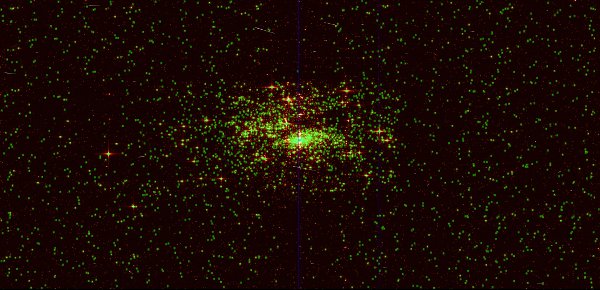IoW_20110622 - Gaia
Image of the Week |
Gaia's view of open clusters: a case study of R136 in the Large Magellanic Cloud |
 |
|
Gaia will observe thousands of open clusters in the galactic disk but will also reach clusters in the Magellanic Clouds. This image - courtesy Jos de Bruijne and Guido De Marchi (Research and Scientific Support Department of the European Space Agency) - presents a case study of the massive cluster R136, the central ionising star cluster of the Tarantula nebula (30 Doradus) in the Large Magellanic Cloud. Through simulations using the on-board object-detection software in combination with a cluster membership list based on deep HST images, it is found that, even in this massively dense and crowded environment, Gaia is capable of detecting stars down to 20-th magnitude. The main sequence of the cluster, as well as the field-star red clump, are representatively sampled. The image, representing an astrometric AF2 CCD of the R136 cluster and surroundings, has been generated using the Gaia Instrument and Basic Image Simulator (GIBIS, developed within the Gaia Data Processing and Analysis Consortium – DPAC) based on a user-supplied source list. The default GIBIS configuration has been used, with typical cosmic-ray rates, sky background, CCD noise, etc., but Gaia's secondary telescope – which is normally superimposed at focal-plane level – has been blinded and charge injection has been disabled to ease the interpretation of the simulation. The source list is based on HST WFC3/UVIS images (6848 seconds in F555W ~ V and 10,656 seconds in F814W ~ I, 39 mas pixel-1, 162'' × 162'') taken on 20 October 2009 as part of the WFC3 Early-Release Science (ERS) programme (HST proposal 11360 by O'Connell et al.). The source list extracted from these images extends beyond V = 25 mag and contains 22,081 stars (De Marchi et al., 2011, ApJ, submitted). The associated object density is 11 million stars deg-2. The density of stars with G < 20 mag – which is the Gaia faint limit for astrometry and photometry – is 1.4 million objects deg-2. The source list has been extended with a representative background sample of stars to cover an area equal to the Gaia CCD height (1966 across-scan pixels, or 350'') and spanning 4.0 seconds of Gaia scanning time (4096 along-scan pixels, or 240'', or ~60 pc in linear dimension at the distance of the Large Magellanic Cloud). The extended source list contains 69,166 stars. Feeding this source list to GIBIS, 11,742 sources have been generated, all with G < 22 mag. The green boxes indicate observation windows allocated by the on-board software. More details are available in this poster and the associated legend. A higher resolution poster is available here (17.8M). This work has made extensive use of the Gaia Instrument and Basic Image Simulator (GIBIS), developed by Carine Babusiaux (Observatoire de Paris-Meudon, France) and collaborators within Coordination Unit 2 (CU2) of the Gaia Data Processing and Analysis Consortium (DPAC) and deployed by the Centre National d'Études Spatiales (CNES, Toulouse, France), as well as of the Gaia Video Processing Algorithms (VPA) prototype, developed by EADS Astrium SAS (Toulouse, France). Carmen Blasco (Research and Scientific Support Department, ESA) kindly provided support with running GIBIS and interpreting the results. Image: Jos de Bruijne and Guido De Marchi [Published: 22/06/2011] |
- Removed a total of (3) style text-align:center;
- Removed a total of (5) style text-align:justify;
- Removed a total of (1) border attribute.
- Removed a total of (1) cellpadding attribute.
- Removed a total of (1) cellspacing attribute.
Image of the Week Archive
- Removed a total of (1) border attribute.
- Removed a total of (1) cellpadding attribute.
- Removed a total of (1) cellspacing attribute.








































 Sign in
Sign in
 Science & Technology
Science & Technology
